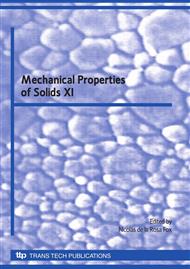p.99
p.105
p.113
p.119
p.125
p.131
p.137
p.147
p.155
Sliding Wear Behavior of a Duplex Stainless Steel
Abstract:
Duplex stainless steels contain similar amounts of austenite and ferrite α. This two-phase microstructure leads to an excellent combination of mechanical properties and corrosion resistance. However, there are few works dealing with the wear behaviour of these steels. This paper aims to determine the sliding wear mechanisms of a duplex stainless steel type 2205. In order to do it, three different sliding velocities (0.2, 0.7 and 1.2 m/s) and six sliding distances (500, 1000, 2000, 3000, 4000 and 5000 m) were selected. The results show that wear rate depends on both sliding velocity and sliding distance. The wear mechanisms detected were plowing, microcracking and microcutting (typical mechanisms of fatigue wear). These mechanisms evolve according to sliding velocity and sliding distance, highlighting a transition zone in which wear rate is reduced.
Info:
Periodical:
Pages:
125-130
Citation:
Online since:
December 2009
Authors:
Keywords:
Price:
Сopyright:
© 2010 Trans Tech Publications Ltd. All Rights Reserved
Share:
Citation:


